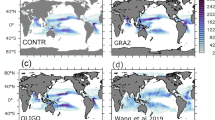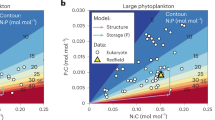Abstract
A simple model has the potential to resolve the long-running debate amongst oceanographers over whether nitrogen or phosphorus exerts overall control on oceanic primary production. A representation of the competition between nitrogen-fixing and other phytoplankton is inserted into a two-box global model of the oceanic nitrogen and phosphorus cycles. Homeostatic regulation of both nitrate and phosphate concentrations results, with surface waters more deficient in nitrate than phosphate in the steady state, but with external phosphate inputs controlling longer-term primary production in the global ocean.
This is a preview of subscription content, access via your institution
Access options
Subscribe to this journal
Receive 51 print issues and online access
$199.00 per year
only $3.90 per issue
Buy this article
- Purchase on Springer Link
- Instant access to full article PDF
Prices may be subject to local taxes which are calculated during checkout




Similar content being viewed by others
References
Redfield, A. C. in James Johnston Memorial Volume 176–192 (Liverpool Univ. Press, (1934).
Broecker, W. S. & Peng, T.-H. Tracers in the Sea (Lamont-Doherty Geological Observatory, New York, (1982).
Libes, S. M. An Introduction to Marine Biogeochemistry (Wiley, New York, (1992).
Schindler, D. W. Evolution of phosphorus limitation in lakes. Science 195, 260–262 (1977).
Schindler, D. W. Whole-lake eutrophication experiments with phosphorus, nitrogen and carbon. Int. Ver. Theor. Angew. Limnol. Verh. 19, 3221–3231 (1975).
Smith, V. H. Low nitrogen to phosphorus ratios favor dominance by blue-green algae in lake phytoplankton. Science 221, 669–671 (1983).
Hecky, R. E. & Kilham, P. Nutrient limitation of phytoplankton in freshwater and marine environments: a review of recent evidence on the effects of enrichment. Limnol. Oceanogr. 33, 796–822 (1988).
Howarth, R. W., Marino, R. & Cole, J. J. Nitrogen fixation in freshwater, estuarine and marine ecosystems. 2. Biogeochemical controls. Limnol. Oceanogr. 33, 688–701 (1988).
Geochemical Oceans Section Study (GEOSECS) data set.(cited (1996) 〈http://ingrid.ldgo.columbia.edu/SOURCES/.GEOSECS〉.
Tyrrell, T. & Law, C. S. Low nitrate:phosphate ratios in the global ocean. Nature 387, 793–796 (1997); Low nitrate: phosphate ocean ratios corrected. Nature 393, 318 (1998).
Ryther, J. G. & Dunstan, W. M. Nitrogen, phosphorus and eutrophication in the coastal marine environment. Science 171, 1008–1013 (1971).
Codispoti, L. A. in Productivity of the Ocean: Present and Past (eds Berger, W. H., Smetacek, V. S. & Wefer, G.) 377–394 (Dahlem Conf., Wiley, Chichester, UK, (1989).
Codispoti, L. A. Is the ocean losing nitrate? Nature 376, 724 (1995).
Falkowski, P. G. Evolution of the nitrogen cycle and its influence on the biological CO2pump in the ocean. Nature 387, 272–275 (1997).
Smith, S. V. Phosphorus versus nitrogen limitation in the marine environment. Limnol. Oceanogr. 29, 1149–1160 (1984).
Broecker, W. S. Akinetic model for the composition of sea water. Quat. Res. 1, 188–207 (1971).
Jahnke, R. A. in Global Biogeochemical Cycles (eds Butcher, S. S., Charlson, R. J., Orians, G. O. & Wolfe, G. V.) 301–315 (Academic, London, (1992).
Mackenzie, F. T., Ver, L. M., Sabine, C., Lane, M. & Lerman, A. in Interactions of C, N, P and S Biogeochemical Cycles and Global Change (eds Wollast, R., Mackenzie, F. T. & Chou, L.) 1–61 (NATO ASI Ser. Vol. 14, Springer, Berlin, (1993).
Jaffe, D. A. in Global Biogeochemical Cycles (eds Butcher, S. S., Charlson, R. J., Orians, G. O. & Wolfe, G. V.) 263–284 (Academic, London, (1992).
Fasham, M. J. R., Ducklow, H. W. & McKelvie, S. M. Anitrogen-based model of plankton dynamics in the oceanic mixed layer. J. Mar. Res. 48, 591–639 (1990).
Kimmerer, W. J., Smith, S. V. & Hollibaugh, J. T. Asimple heuristic model of nutrient cycling in an estuary. Estuar. Coast. Shelf Sci. 37, 145–159 (1993).
Banse, K. in Primary Productivity and Biogeochemical Cycles in the Sea (eds Falkowski, P. G. & Woodhead, A. D.) 409–439 (Plenum, New York, (1992).
Christensen, J. P., Townsend, D. W. & Montoya, J. P. Water column nutrients and sedimentary denitrification in the Gulf of Maine. Cont. Shelf Res. 16, 489–515 (1996).
Anderson, L. A. & Sarmiento, J. L. Redfield ratios of remineralisation determined by nutrient data analysis. Glob. Biogeochem. Cycles 8, 65–80 (1994).
Söderström, J. The significance of observed nutrient concentrations in the discussion about nitrogen and phosphorus as limiting nutrients for the primary carbon flux in coastal water ecosystems. Sarsia 81, 81–96 (1996).
Smayda, T. J. Narragansett Bay: variability and change in environment and phytoplankton dynamics over a 23-year period.(Abstr.) Estuaries 8, 86 (1985).
Boddeke, R. & Hagel, P. in Proc. World Fisheries Congress, Theme 1 (ed. Armantrout, N. B.) 290–315 (Oxford & IBH, PVT, New Delhi, (1994).
Nanninga, H. J., Gieskes, W. W. C. & Wolff, W. J. Fish Production in the North Sea and the Influence of Nitrogen and Phosphorus (Literature Study, Dept of Marine Biology, Univ. Groningen, (1997).
Suess, E. Particulate organic carbon flux in the oceans—surface productivity and oxygen utilisation. Nature 288, 260–263 (1980).
Martin, J. H., Knauer, G. A., Karl, D. M. & Broenkow, W. W. VERTEX: carbon cycling in the northeast Pacific. Deep-Sea Res. 34, 267–285 (1987).
Schlesinger, W. H. Biogeochemistry: an Analysis of Global Change (Academic, San Diego, (1991).
Meybeck, M. in Interactions of C, N, P and S Biogeochemical Cycles and Global Change (eds Wollast, R., Mackenzie, F. T. & Chou, L.) 163–193 (NATO ASI Ser. Vol. 14, Springer, Berlin, (1993).
Berner, E. K. & Berner, R. A. Global Environment: Water, Air, and Geochemical Cycles (Prentice-Hall, NJ, (1996).
Cornell, S., Rendell, A. & Jickells, T. Atmospheric inputs of dissolved organic nitrogen to the oceans. Nature 376, 243–246 (1995).
Duce, R. A. et al. The atmospheric input of trace species to the world ocean. Glob. Biogeochem. Cycles 5, 193–259 (1991).
Copin-Montegut, C. & Copin-Montegut, G. Stoichiometry of carbon, nitrogen, and phosphorus in marine particulate matter. Deep-Sea Res. 30, 31–46 (1983).
Ríos, A. F., Fraga, F. & Pérez, F. F. Estimation of coefficients for the calculation of “NO”, “PO” and “CO”, starting from the elemental composition of natural phytoplankton. Scientia Marina 53, 779–784 (1989).
Furnas, M. J. In situ growth rates of marine phytoplankton: approaches to measurement, community and species growth rates. J. Plankt. Res. 12, 1117–1151 (1990).
McAllister, C. D., Shah, N. & Strichland, J. D. H. Marine phytoplankton photosynthesis as a function of light intensity: a comparison of methods. J. Fish. Res. Board Can. 21, 159–181 (1964).
Davies, A. G. & Sleep, J. A. The photosynthetic response of nutrient-depleted dilute cultures of Skeletonema costatum to pulses of ammonium and nitrate; the importance of phosphate. J. Plankt. Res. 11, 141–164 (1981).
Eppley, R. W., Rogers, J. N. & McCarthy, J. J. Half-saturation constants for uptake of nitrate and ammonium by marine phytoplankton. Limnol. Oceanogr. 14, 912–920 (1969).
Goldman, J. C. & Glibert, P. M. in Nitrogen in the Marine Environment (eds Capone, D. G. & Carpenter, E. J.) 233–274 (Academic, New York, (1983).
Barnes, R. S. K. & Hughes, R. N. An Introduction to Marine Ecology 2nd edn (Blackwell Science, Oxford, (1988).
Antoine, D., André, J.-M. & Morel, A. Oceanic primary production, 2. Estimation at global scale from satellite (Coastal Zone Colour Scanner) chlorophyll. Glob. Biogeochem. Cycles 10, 57–69 (1996).
Levitus, S., Conkright, M. E., Reid, J. L., Najjar, R. G. & Mantyla, A. Distribution of nitrate, phosphate and silicate in the world oceans. Prog. Oceanogr. 31, 245–273 (1993).
Longhurst, A., Sathyendranath, S., Platt, T. & Caverhill, C. An estimate of global primary production in the ocean from satellite radiometer data. J. Plank. Res. 17, 1245–1271 (1995).
Capone, D. G., Zehr, J. P., Paerl, H. W., Bergman, B. & Carpenter, E. J. Trichodesmium, a globally significant cyanobacterium. Science 276, 1221–1229 (1997).
Gruber, N. & Sarmiento, J. L. Global patterns of marine nitrogen fixation and denitrification. Glob. Biogeochem. Cycles 11, 235–266 (1997).
Vitousek, P. M. & Howarth, R. W. Nitrogen limitation on land and in the sea: How can it occur?. Biogeochemistry 13, 87–115 (1991).
Acknowledgements
I thank E. Marañón, T. Lenton, A. Martin, D. Wolf-Gladrow, T. Anderson, H.Nanninga, J. Shepherd, P. Holligan, P. Herman, W. Stolte, C. Zonneveld, A. Taylor, A. Watson, L. Partridge, W. Barkmann, S. Smith and R. Toggweiler for discussions and comments on the manuscript, and A. Brice for assistance with computing.
Author information
Authors and Affiliations
Corresponding author
Supplementary information
Rights and permissions
About this article
Cite this article
Tyrrell, T. The relative influences of nitrogen and phosphorus on oceanic primary production. Nature 400, 525–531 (1999). https://doi.org/10.1038/22941
Received:
Accepted:
Issue Date:
DOI: https://doi.org/10.1038/22941
This article is cited by
-
Biogeochemical explanations for the world’s most phosphate-rich lake, an origin-of-life analog
Communications Earth & Environment (2024)
-
A phosphate-rich marine reservoir in the redox stratified Ediacaran ocean
Communications Earth & Environment (2024)
-
Spatial and temporal variation in surface nitrate and phosphate in the Northern Gulf of Mexico over 35 years
Scientific Reports (2024)
-
Spatio-temporal patterns in the biomass, species composition and nitrogen content of drift macroalgae in an urbanised coastal embayment
Journal of Applied Phycology (2024)
-
Gelatinous versus non-gelatinous zooplankton: their value as food for planktivorous coral reef fishes
Coral Reefs (2024)
Comments
By submitting a comment you agree to abide by our Terms and Community Guidelines. If you find something abusive or that does not comply with our terms or guidelines please flag it as inappropriate.



